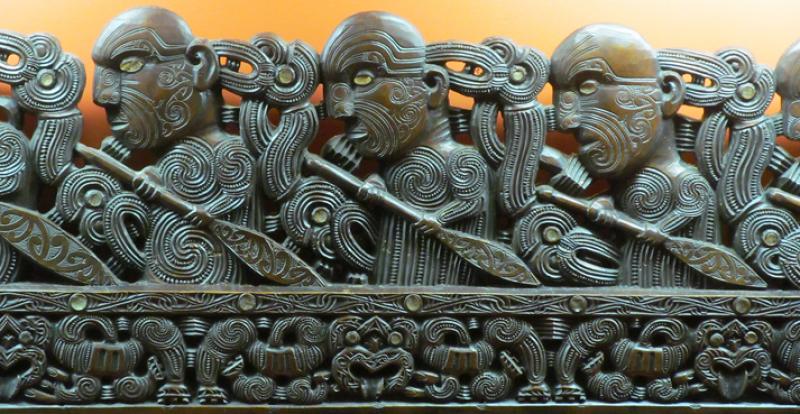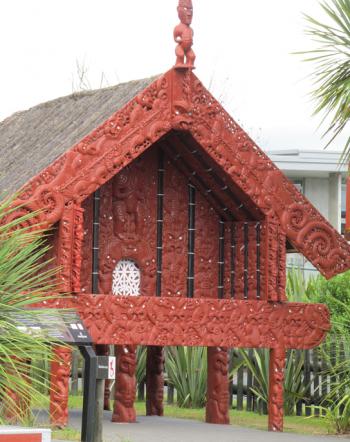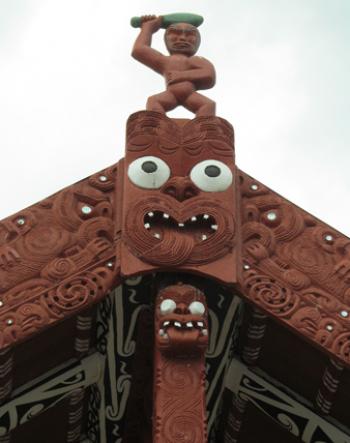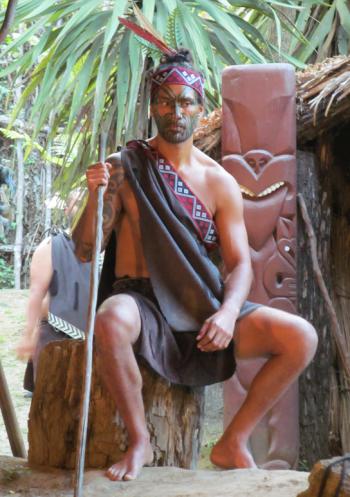The Māoris of Aotearoa (First of two parts)
This item appears on page 27 of the October 2020 issue.
Undoubtedly, New Zealand is a country of spectacular beauty. Consisting primarily of two large islands — the North Island and the South Island — it is in the South Pacific Ocean. New Zealand is a land of snow-covered mountains, deep lakes, long fjords and verdant valleys as well as gentle hills, sandy and craggy coastlines and farmland.
I first visited many years ago. The opportunity to return came in February 2020. Besides the abundant natural beauty that my husband, Paul, and I knew we would find on this trip, we wanted to experience the cultural richness that New Zealand is blessed with in its unique Māori heritage.
Before the Europeans
Long before the sealers and whalers who sailed New Zealand’s waters before European contact and before the exploratory visits of Dutch captain Abel Tasman in 1642 and English captain James Cook in 1769, the Māoris had occupied both large islands of New Zealand, which they called Aotearoa, or Land of the Long White Cloud.
There is still much debate about where the ancestors of the Māoris originally migrated from, and when. The consensus now seems to be that a great migration began out of Southeast Asia tens of thousands of years ago, moving eastward into New Oceania, where the Solomon Islands and the islands northeast of Papua New Guinea are located.
Much later, another movement eastward took peoples to western Polynesia (Tonga, Fiji and Samoa) by about 1500 to 1000 BC and to central and eastern Polynesia (the Cook, Marquesas and Society islands) at about the time of Christ or a little earlier.
Rapa Nui/Easter Island was probably reached by AD 400 to 500 and Hawaii, possibly about the same time or a little later. Just remember that all these dates are up for debate. Ask three people, get 10 opinions, but it does give you a general idea of the movement eastward across the Pacific.
Among the last of the islands in the Pacific to be reached was New Zealand. Māori songs and legends tell of large oceangoing vessels called waka setting out — probably from central Polynesia — guided by ocean currents, winds and stars to New Zealand.
This migration probably took place between AD 900 and 1300, taking these first peoples of New Zealand to a land rich in resources, where they hunted, fished and farmed. Even today, Māori families trace their genealogies back to one of the original waka migratory boats.
Rotorua, located on the North Island 142 miles southeast of Auckland, New Zealand’s largest city, is where Paul and I found the richest concentration of Māori sites/sights and where we spent four days.
Te Puia
The first Māori site we visited was Te Puia (phone +64 7 348 9047, tepuia.com), 2½ miles from Rotorua. This extensive site offers both natural phenomena and Māori architecture, history and culture. It is the kind of place that visitors expect to spend a few hours at and wind up staying the entire day.
Beginning near the Heketanga-ā-Rangi, the dramatic contemporary Māori entrance to the complex, a geothermal trail leads visitors past bubbling mud pools and boiling water pits to Pōhutu, the largest geyser in the Southern Hemisphere. Shooting up to 100 feet into the air, Pōhutu erupts once or twice each hour but not on a fixed time schedule.
New Zealand is famed for its geothermal spots. Rotorua is one of the best places in the country to experience geysers, hot springs and mud pools, and Te Puia is the outstanding spot within Rotorua.
Reconstructed Māori village
Also close to the entrance of Te Puia is Pikirangi, a reconstruction of a Māori village as it may have looked before the arrival of Europeans. The reconstruction is built on top of an actual ancient habitation site of the Māori Ngāti Tama tribe and includes examples of a whare, or sleeping house, pātaka, storehouse, wharewhakairo, meeting house (literally, woodcarving house or wood-carved house), and māra, garden.
Close to Pikirangi Village is the rotowhio marae, the Māori gathering place where the wharenui, or principal house, stands. The wharenui displays traditional Māori carving inside and outside. It is here that song and dance performances are held two or three times each day. It’s a do-not-miss event.
Also on site is the wananga, where students learn the arts of woodcarving and weaving. Visitors can watch students at work carving sculptures and panels either individually or in teams. The short path leading to the wananga is lined with imposing, red-painted wood figures.
Currently, Te Puia’s winter hours are 10 a.m. to 4 p.m., Thursday through Sunday, but, as with any site, call or email ahead of any visit to check. (As compared to those in North America, the seasons are reversed in New Zealand. The New Zealand months of December, January and February are summertime; June, July and August are wintertime.)
A daytime admission pass costs NZD60 (near $40) per person. There are also various packages that include a steam box lunch, a Māori feast or a cultural performance. Te Puia also offers evening “experiences” that include a hangi, in which Māori food is cooked in an earth pit using heated rocks, and a cultural performance.
The Buried Village
At the next site we visited, we stepped into the past at Te Wairoa (phone +64 7 362 8287, buriedvillage.co.nz), 9½ miles from Rotorua. On June 10, 1886, Mt. Tarawera erupted. Rocks, ash and mud spewed out of the mountain. The Pink and White Terraces that had formed over the centuries from silica-rich water were destroyed.
The terraces were considered the eighth wonder of the world by late-19th-century New Zealanders. (From period photos, the Pink and White Terraces reminded me of the terraces of Pamukkale in Turkey.)
Also in the path of destruction was the village of Te Wairoa, where 150 people lost their lives and where buildings — both Māori and European — disappeared beneath the mud and rocks. There is now a museum on site displaying some of the items excavated from the ruins, including crockery, bottles and shoes. Māori carvings are also on exhibit.
From the museum, a trail leads to some of the sites buried by the eruption: the village blacksmith’s house and shop; the whare of a Māori tohunga, or priest; a flour mill, and a stone storehouse. Gone are the hotels where visitors coming to see the terraces once stayed, although the foundations of the Rotomahana Hotel were excavated in 1986, 100 years after the eruption.
Te Wairoa, also called The Buried Village, is open 9 to 5 during the summer and 9 to 4:30 in the winter. Admission is NZD35 ($23.50) per person.
Living village
For a taste of what modern-day Māori life is like, there is no better place to visit than the village of Whakarewarewa (phone +64 7 349 3463, whakarewarewa.com), about 3 miles from Rotorua.
This is an actual living village, not a re-creation or a museum collection of Māori buildings. Visitors can walk past Māori homes with small gardens where food is still cooked in steam boxes or in pools of boiling geothermal water.
Dotted around the village are springs and geysers and, among them, shops and the Whaka Café, where typical Māori food — perhaps chicken, beef, kumara (sweet potato), carrots, bread stuffing and cabbage — can be sampled. Nearby is the whare tūpuna, the ancestral meeting house, still important in the village’s everyday life.
Performances of song and dance are scheduled several times each day. There are also four trails visitors can follow within and beyond the village, from a truly short 5-minute walk to a one-hour-long track with lookout points, mud pools and a lake.
Whakarewarewa currently has reduced hours: 10 a.m.-2 p.m., Wednesday to Sunday. Admission costs NZD45 ($30) per person.
Cultural performance
During our three weeks in New Zealand, Paul and I attended four cultural performances of Māori song and dance. The best of these, we felt, was at the Mitai Māori Village (phone +64 7 343 9132, mitai.co.nz), 3 miles from Rotorua. An excellent performance was capped off by a Māori buffet of typical foods. Visitors sat at communal tables in an open-air thatched building.
Mitai Māori Village is open daily from 8 to 7, with hangi feasts following the evening performances (check for times). The cost for the performance and hangi is NZD123 ($82.50) per person.
Thermal wonderland
One final place that shouldn’t be missed on any trip to Rotorua is Wai-o-tapu (phone 64 7 366 6333, waiotapu.co.nz), a geothermal area formed about 150,000 years ago.
Located 10 miles from Rotorua, Wai-o-tapu is described in brochures as a “thermal wonderland.” It is. There are three trails one can follow that range in length from 2½ to 3 miles. You can take a self-guided tour of boiling mud and water pools, steaming fumaroles and collapsed craters. It’s an eerie world to walk through.
Wai-o-tapu is currently open 9-4 daily (last admission at 3). Admission is NZ32.50 ($22).
An exciting blend of geothermal activity and Māori culture, Rotorua is one of the most fascinating parts of New Zealand. It is wise to allow a minimum of three days for a visit. Four or five would be better. We spent four days — barely enough time, we thought, for anyone interested in the Māoris.
If you go…
Paul and I stayed at the modern Novotel Rotorua Lakeside in Rotorua. We loved its location only steps away from Tutanekai Street, also called Eat Street, lined on both sides with moderately priced restaurants, most with outside seating. There were Indian, Thai, Italian, Mexican and Tunisian restaurants as well as a steakhouse and pubs.
Looking ahead, for a room in February 2021, rack rates at the Novotel Rotorua range from $184 to $300 for up to two adults and two children.
Most of our travel arrangements for our New Zealand trip were made by Aspire Down Under (877/727-7473 or 212/850-0946, www.aspiredownunder.com), a company based in New York City that specializes in New Zealand and Australia, also Fiji, Tahiti, Papua New Guinea and the Cook Islands. They reserved our accommodations for our 12 days traveling outside Auckland and almost all of our tours out of Auckland as well.
We cannot praise Aspire Down Under enough, nor the agent Joanne Morgan, who spent tons of time meticulously planning with us what best to see and do. Aspire Down Under is a superlative company to work with. It’s what all travel companies should aspire to.
Our tour of Māori sites/sights in other parts of New Zealand continues in the November 2020 issue.




